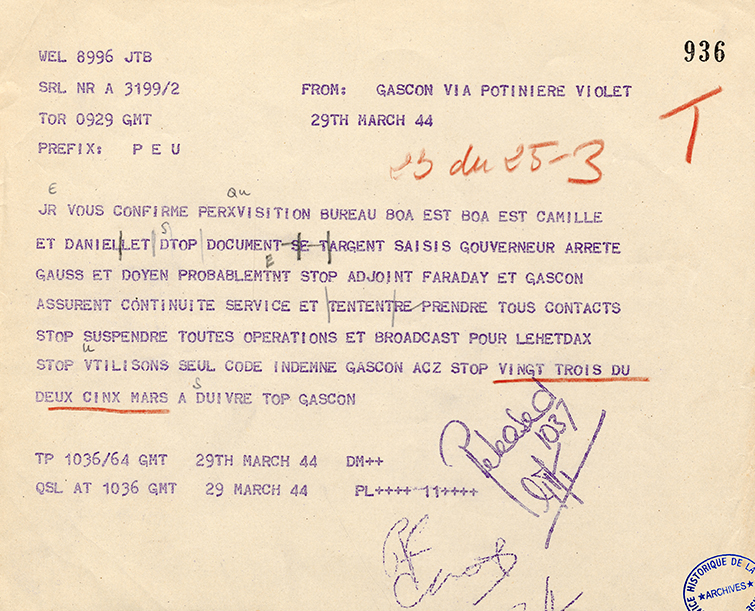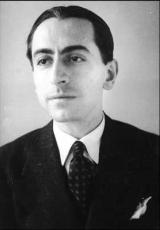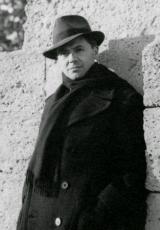Les Transmissions in service of action
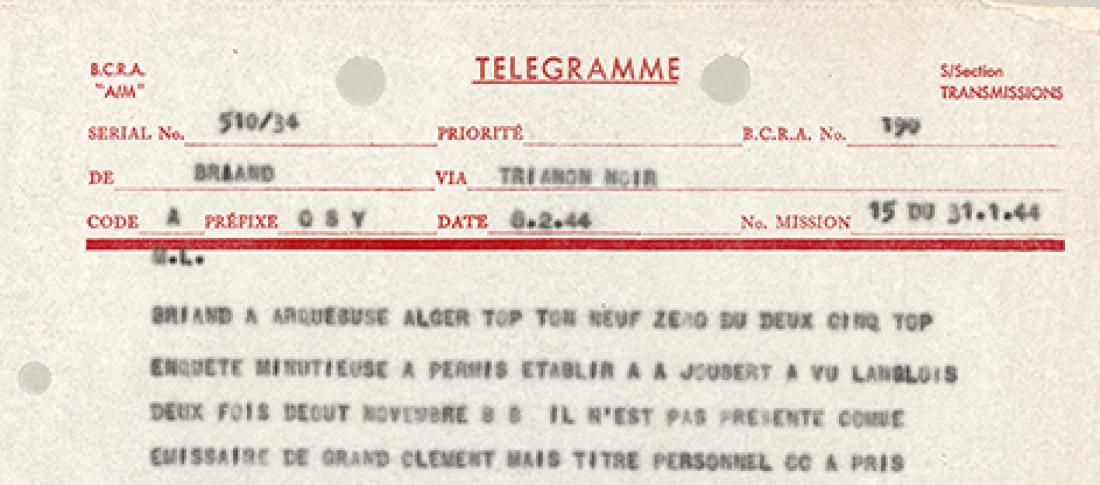
One of the great treasures of the special services archives is the collection of cables and telegrams. Conserved at the National Archives and the Defence Historical Service, these documents have their own logic and contain many secrets. They reveal the daily life of the Resistance and make it possible to reconstruct, sometimes with surprising precision, the circuits by which information and decisions were exchanged and thus to improve our understanding of the operations of the Resistance in the field.
The documents take the form of short, typewritten texts transcribing radiotelegraphic exchanges between the London and Algiers centres (”Home Station”) and the Resistance networks based in occupied France, which were allocated trained radio operators infiltrated clandestinely to send and/or receive encrypted messages on dedicated equipment (”Out Station”) in Morse code.
The war of the airwaves
As the Bureau central de renseignements et d'action (BCRA, Central Bureau of Intelligence and Operations) gave each ”pianist” a code name to use in all radio contact, its staff classified all communications using these codes, and could match the operator's code name to their network and region of activity at any time. After the war, knowledge of this matching faded. This is no doubt why the inventories prepared by the archivists at the National Archives and the Service historique de la défense (SHD, Defence Historical Service) favour classification by code rather than surname or even network. Convenience took priority.
This complicates the work of today's researchers. But that is not all. Reading the cables can be disconcerting for anyone without sufficient prior knowledge. A full understanding requires a good command of the background. Moreover, these cables are full of pseudonyms, code names and aliases that had to be impenetrable in order to disorient the enemy in wartime. The enemy is no longer there, but the aliases continue to resist…
Clearly, any researcher who undertakes a quest to analyse the cables without being able to match true identities to code names, networks and regions would quickly become discouraged. But what a joy for anyone who can identify and locate Boss, Ex-20, Pioche, Alceste, Rectangle, Bip, Bip-W, Pal, Pal-W, Bel, Kim, Rod, Iroquois, Clovis, Brumaire or Fana, or who knows what kinds of missions, functions and concepts certain ”series” refer to! While the first cables presented here have been selected with the aim of helping neophytes to find their way through the nebulous world of the BCRA's pseudonyms, the remainder were chosen to underline the importance of the communications and transmissions between free France and captive France at various levels and in various circumstances. Keeping everyone informed means both acting and enabling others to act.
Du BCRA à REX ZO, n°50, 29 juillet 1943, ”Pour Sophie” (voir diaporama)
Le 29 juillet 1943, le BCRA informe Sophie, alias Claude Serreulles, chargé à Paris de l'intérim de la Délégation générale, qu'il se référera à des séries thématiques pour attribuer des pseudos à ses agents. Moyennant quoi, les chefs de missions civiles auront des noms d'hommes d'État (Danton, Necker), les radios des noms de peuples (Berbère, Gascon), les saboteurs des noms de bateaux (Barque, Pakebot/Paquebot) et les officiers chargés des opérations aériennes des noms de savants (Gauss, Faraday, Mariotte). Les théâtres parisiens sont mis à contribution pour désigner les plans de transmissions (Bouffes Parisiens, Deux Anes, Michodière). Quant aux villes d'Afrique du Nord, elles renverront aux plans d'écoute ou Broadcast (Agadir, Tlemcen).
Cette façon de faire sera reprise ultérieurement et de nouvelles séries thématiques apparaîtront, parfois en se substituant aux anciennes par mesure de sécurité : les saboteurs porteront des noms d'outils (Fléau, Lime, Pelle) et les chefs des missions civiles deviendront des personnages des pièces de Molière (Oronte, Philinte). Quant aux délégués militaires mis en place à compter de l'automne 1943, ils se cacheront derrière des termes de géométrie (Losange, Droite, Ligne).
De REX à BCRA, n°3, 29 mai 1943 (voir diaporama)
Le 29 mai 1943, Rex, alias Jean Moulin, annonce personnellement au BCRA la tenue de la première réunion plénière du Conseil national de la Résistance (CNR) ainsi que le nom des organisations représentées. L'événement est célèbre, le document historique. Il est à noter que le câble de Rex indique la date du 25 mai, qui est celle du jour initialement prévu avant que la réunion constitutive du Conseil national de la Résistance ne soit reportée au 27, parce qu'au dernier moment Louis Marin de la Fédération républicaine fut empêché et que Rex tenait à ce que les 16 organisations soient représentées physiquement. On observera que ce câble est arrivé à Londres le 2 juin.
De OYSTER au BCRA, 1er juillet 1943 (voir diaporama)
Le 1er juillet 1943, Oyster, alias Michel Pichard, chef du bloc Est du Bureau des opérations aériennes (BOA) rédige son câble n°35 pour informer Londres qu'en Côte-d'Or, deux équipes sont prêtes à recevoir un parachutage Arma (nom de code pour un parachutage d'armes) sur leur terrain dûment homologué et repéré grâce aux cartes Michelin 65 et 66, de banales cartes routières au 1/200 000 dont le carroyage est précieux pour définir les coordonnées d'un point. Reçu à Londres le 6, ce câble contient les éléments essentiels à toute opération aérienne secrète organisée par les ”Gens de la Lune”, comme ils aimaient à s'appeler : nom et coordonnées d'un terrain clandestin, message mobilisateur et moyen de reconnaissance.
Un des terrains a reçu le nom de code Anjou. Il se situe près de Poiseul-la-Grange (30 km au nord-ouest de Dijon). L'autre terrain, Poitou, est sis près de Saint-Philibert (canton de Gevrey-Chambertin, 15 km au sud de Dijon). Quatre phrases convenues sont communiquées au BCRA pour que, le jour venu, quand l'avion de la RAF s'apprêtera à mettre le cap sur l'est de la France, après en avoir reçu l'ordre de l'Air Ministry, le speaker de la BBC les énonce : Le chameau bêle ou Le mouton mugit, pour Anjou, Les guitares sont muettes ou Francine est chauve, pour Poitou. Alors, une fois les ”messages personnels” égrenés et le poste de TSF familial éteint, les équipiers du terrain concerné gagneront discrètement le lieu de rendez-vous. Vers minuit, à l'approche de l'avion, l'équipe se signalera à l'équipage en lui adressant, au moyen d'une lampe de poche, une lettre de reconnaissance en morse : P pour ceux d'Anjou, Q pour ceux de Poitou. Alors les soutes s'ouvriront et les containers tomberont, dix au maximum à cause des dimensions du terrain et du nombre des volontaires.
Précisons que Poitou et son équipe dirigée par Alix Lhote, jeune instituteur du village de Saint-Philibert, ont reçu le premier des parachutages du BOA de Côte-d'Or dans la nuit du 16 au 17 juillet 1943. Quatre nuits plus tôt, celle du 12-13, Acrobat, un réseau du Special Opérations Executive (SOE) dirigé par John Starr, un officier britannique parachuté, avait connu un semblable succès, à 15 km de là, entre Arcenant et Meuilley, à proximité de Nuits-Saint-Georges.
Du BCRA à OYSTER, 8 septembre 1943 (voir diaporama)
Le 8 septembre 1943, le BCRA informe Oyster d'une opération possible sur Vendée à compter du 15. Il s'agit d'une opération Homo (code pour parachutage d'agents) sur laquelle le BCRA se montre très discret. S'il peut en être ainsi, c'est parce le BCRA fait confiance à ses agents : il sait que Michel Pichard est en mesure de s'y rendre ou d'y envoyer son adjoint.
Précisons que Vendée est un terrain de Côte-d'Or, situé au nord de Saulx-le-Duc, près de Luxerois, dans le canton d'Is-sur-Tille. En début de soirée, la BBC avait diffusé la phrase convenue : La servitude est obscure, avant qu'au cœur de la nuit du 15-16, ne soient parachutés avec succès sur Vendée : Raymond Fassin, délégué militaire pour la région A, Maurice de Cheveigné, radio, Pierre Jans, radio, et Michel Gries, instructeur en sabotage.
From the BCRA to REX ZO, no. 50, 29 July 1943, ”For Sophie” (see slideshow)
On 29 July 1943, the BCRA informed Sophie, alias Claude Serreulles, temporarily responsible for the General Delegation in Paris, that it would refer to themed series when allocating pseudonyms to its agents. Heads of civilian missions would be named after statesmen (Danton, Necker), radios after names of peoples (Berber, Gascon), saboteurs after names of boats (barque, ”paquebot” or liner) and officers in charge of air operations after scientists (Gauss, Faraday, Mariotte). Parisian theatres were used to refer to transmission schedules (Bouffes Parisiens, Deux Anes, Michodière). Cities in North Africa represented listening or broadcast schedules (Agadir, Tlemcen).
This method was reused later, and further themed series emerged, sometimes replacing previous ones for added security: saboteurs were given the names of tools (”Fléau” or flail, ”Lime” or file, ”Pelle” or shovel) and the heads of civilian missions became characters from Molière plays (Oronte, Philinte). The military delegates instituted from autumn 1943 were disguised by geometrical terms (”Losange” or diamond, ”Droite” or straight, ”Ligne” or line).
From REX to the BCRA, no. 3, 29 May 1943 (see slideshow)
On 29 May 1943, Rex, alias Jean Moulin, personally announced to the BCRA that the first plenary meeting of the Conseil national de la Résistance (CNR, National Resistance Council) had taken place, together with the names of the organisations represented. The event is famous and the document historic. Note that the cable from Rex gives the date as 25 May, the date initially planned, but the meeting to constitute the CNR was actually postponed to the 27 because at the last moment Louis Marin of the Fédération républicaine could not attend and Rex wanted all sixteen organisations to be represented in person. We can see that the cable arrived in London on 2 June.
From OYSTER to the BCRA, 1 July 1943 (see slideshow)
On 1 July 1943, Oyster, alias Michel Pichard, the head of the Bureau des opérations aériennes (BOA, Air Operations Bureau), wrote cable no. 35 to inform London that two teams on the Côte d'Or were ready to receive an Arma parachute drop (the code name for a drop of weapons) in their duly approved territory identified by Michelin maps 65 and 66, the standard 1:200,000 road maps whose references were a valuable means of defining the coordinates of a point. Received in London on 6 July, the cable contains all the elements essential for any secret air operation organised by the ”People of the Moon”, as they liked to call themselves: name and coordinates of a clandestine plot of land, mobilising message and means of recognition.
One of the plots of land was given the code name Anjou. It is located near Poiseul-la-Grange (30 km north-west of Dijon). The other, Poitou, is near Saint-Philibert in the canton of Gevrey-Chambertin, 15 km south of Dijon. Four agreed phrases are communicated to the BCRA so that when the day arrives and the RAF plane is preparing to head for eastern France, having received the order from the Air Ministry, the BBC announcer will read them out: Le chameau bêle (”The camel is bellowing”) or Le mouton mugit (”The sheep is bleating”) for Anjou, and Les guitares sont muettes (”The guitars are silent”) or Francine est chauve (”Francine is bald”) for Poitou. Once the ”personal messages” had been read out and the family wireless turned off, the field operatives involved would discreetly make their way to their arranged spot. Towards midnight, as the aircraft approached, the team would announce their presence to the aircrew by flashing a letter in Morse with a torch: P for the Anjou team, Q for Poitou. The hold would open and the containers would be dropped - no more than ten due to the dimensions of the plot of land and the number of volunteers.
Poitou, and the team led by Alix Lhote, the young primary school teacher of the village of Saint-Philibert, received the first BOA parachute drop in Côte-d'Or on the night of 16 to 17 July 1943. Four nights earlier, on 12-13 July, Acrobat, a Special Operations Executive (SOE) network led by John Starr, a British officer parachuted in, had achieved a similar success 15 km away between Arcenant and Meuilley, near Nuits-Saint-Georges.
From the BCRA to OYSTER, 8 September 1943 (see slideshow)
On 8 September 1943, the BCRA informed Oyster of a possible operation in Vendée starting on the 15th. This was a Homo operation (code for an agent parachute drop), about which the BCRA was very discreet. This was only possible because the BCRA trusted its agents: it knew that Michel Pichard would be able to go or to send his deputy.
Vendée was a plot of land in Côte-d'Or, to the north of Saulx-le-Duc near Luxerois in the canton of Is-sur-Tille. At the beginning of the evening, the BBC broadcast the agreed phrase: La servitude est obscure (”Servitude is dark”), and then in the night of the 15-16 September Raymond Fassin, the military delegate for region A, Maurice de Cheveigné and Pierre Jans, radio operators, and Michel Gries, sabotage instructor, were dropped by parachute over Vendée.
BCRA/BRIAND, no. 54, 20 January 1944 and no. 190, 31 January 1944 (see slideshow)
The cable of 20 January 1944 for Briand, alias Pierre Brossolette, plunges us into the ”Grandclément affair”, a sordid story of betrayal with its epicentre in Bordeaux. The key facts were as follows. André Grandclément, the regional head of the Organisation civile et militaire (OCM or Civilian and Military Organisation, at the time the largest Resistance movement in the northern zone), was arrested by the Germans in Paris on 19 September 1943. Quickly buckling under pressure from Friedrich Dohse, SS officer and head of the Bordeaux SIPO-SD, he was released five days later. Dohse was said to be very manipulative. After a number of setbacks affecting the resistance in Bordeaux, the affair took a dramatic turn: Daniel Joubert and André Thinières, both close to Grandclément, crossed the French-Spanish border on 20 December near Hendaye, with the help of Dohse. Incredible as it may sound, they carried a plan for an armistice between the Germans and the resistance to be submitted to the authorities in Algiers. Even more astonishingly, the operation was known to Colonel Alfred Touny, the national head of the OCM! Arriving in Algiers on 5 January 1944, they were received two days later by André Philip, the Interior Commissioner, before being placed under house arrest shortly afterwards (see slideshow).
A flurry of cables was sent from London and Algiers to warn the networks concerned. This cable to Briand is one example. The orders for the networks were clear: ”Immediately cut all contact with Langlois and his circle [i.e. Touny and the OCM staff). Inform all heads of movements of clear collusion between Grandclément and Gestapo. […]. Tell them we have irrefutable proof of contact between Langlois and Grandclément emissaries and Gestapo since November.” In return, other cables followed from France to London, such as the one from 31 January containing Briand's answer and reporting a ”painstaking inquiry”, which can be consulted under the same record number (see slideshow).
From GASCON to the BCRA, 29 March 1944 (see slideshow)
On 29 March 1944, Gascon, alias Guy Baron, a BOA radio operator, confirmed a disaster he had announced on 25 March: the Germans had burst into the BOA eastern bloc office (regions C and D), seized documents and funds and arrested Gouverneur (alias François Delimal), Gauss (alias Michel Pichard) and Doyen (alias Pierre Manuel). There was one slim consolation: Gascon added that he and Faraday (René Collin)'s deputy were able to continue transmissions as one code had escaped the seizures.
This cable reveals the seriousness of the events that had occurred at the BOA office in Rue de Lourmel in Paris' 15th arrondissement, but it also shows that Gascon was not fully informed. In reality, Michel Pichard had not been arrested, though Roger Lebon, Marthe Lebon, Anne-Marie Krug-Basse and Maria Polacek had. Gascon was also unaware that François Delimal, alias Faraday, alias Gouverneur, had committed suicide during his interrogation in Rue des Saussaies, the Paris headquarters of the SIPO-SD.
Michel Blondan
Retired teacher. Doctor of law specialising in the history of the law and institutions.
Author of two books on the customs of Saint-Claude.
His current research covers the Bureau des opérations aériennes, region D.
FOR MORE INFORMATION
The cables and telegrams exchanged between the London and Algiers centres and the networks based in occupied France are conserved at the SHD (sub-series 28 P 5) and the National Archives (sub-series 3AG2).
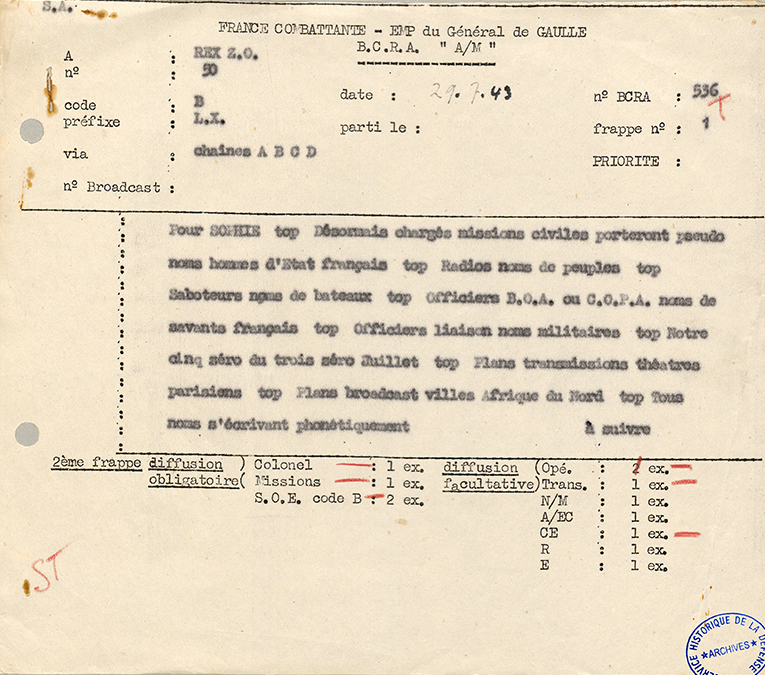
Du BCRA à Rex, 29 juillet 1943.
© SHD
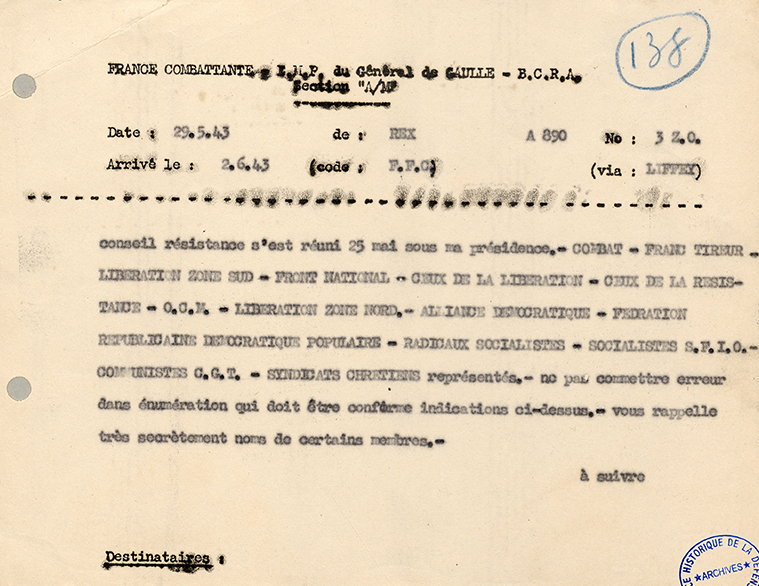
De Rex au BCRA, 29 mai 1943.
© SHD
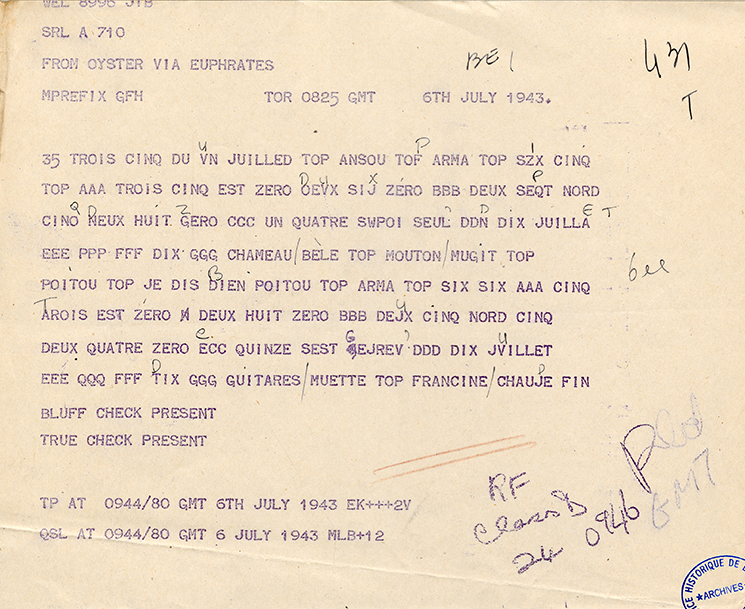
De Oyster au BCRA, 1er juillet 1943.
© SHD
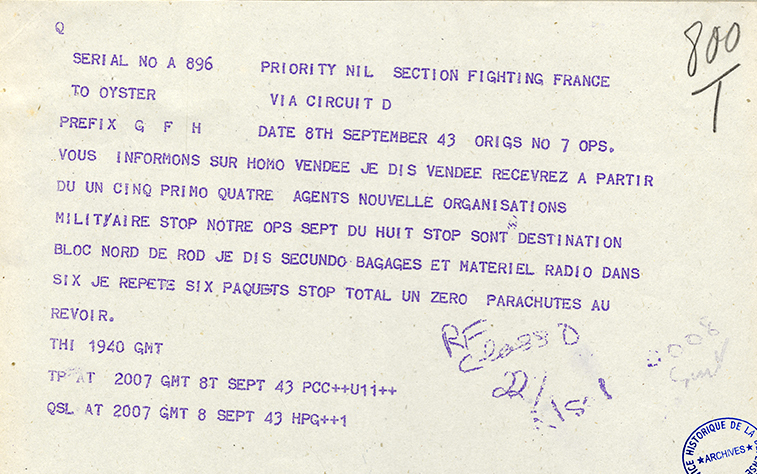
Du BCRA à Oyster du 8 septembre 1943.
© SHD
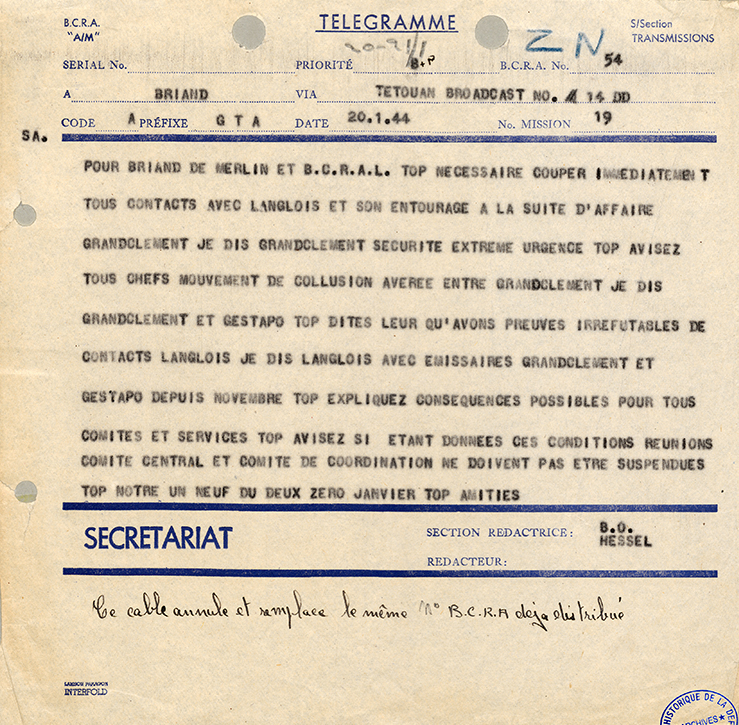
Du BCRA à Briand, 20 janvier 1944.
© SHD
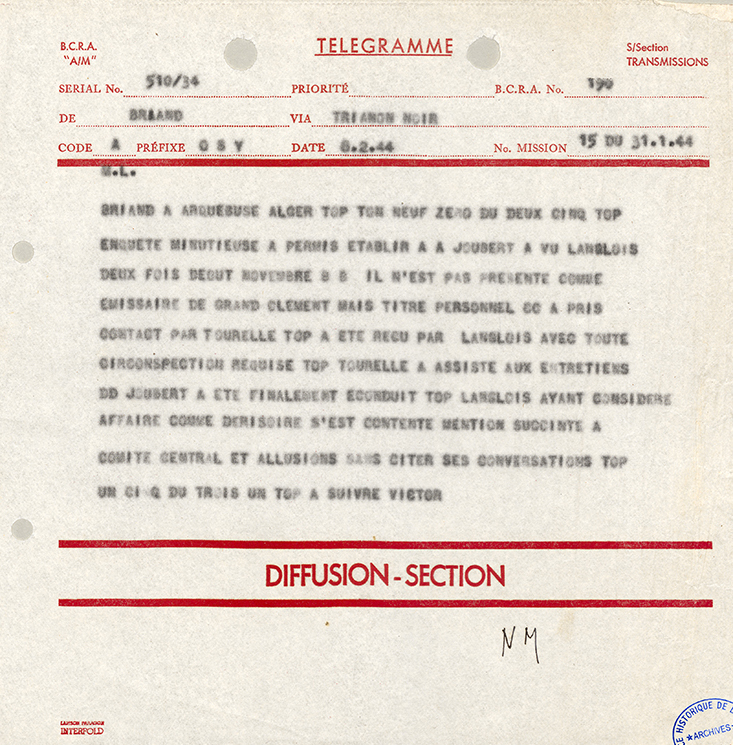
De Briand au BCRA, 31 janvier 1944.
© SHD
